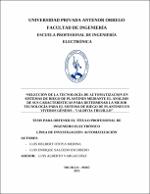Selección de la tecnología de automatización en sistemas de riego de plantines mediante el análisis de sus características para determinar la mejor tecnología para el sistema de riego de plantines en viveros génesis - Valdivia Trujillo

View/
Download
(application/pdf: 1.343Mb)
(application/pdf: 1.343Mb)
Date
2016Author(s)
Otoya Medina, Luis Helbert
Salcedo Escobedo, Luis Enrique
Metadata
Show full item recordAbstract
El presente trabajo de investigación establece una comparativa entre las diferentes tecnologías
de automatización aplicables a los sistemas de riego en viveros, de modo que se pueda establecer
un criterio para la selección de la mejor tecnología. En este trabajo se está tomando como
modelo los viveros Génesis en Valdivia – Trujillo.
En el primer capítulo se hace la introducción al presente trabajo presentando la realidad
problemática que motiva el desarrollo del presente trabajo, la hipótesis y los objetivos.
En el segundo capítulo se presenta el marco teórico en donde se evalúan trabajos de
investigación relacionados con el presente trabajo y además se presentan las teorías sobre las
cuales fundamentamos el mismo.
En el tercer capítulo llamador Material y Método, describimos los pasos que hemos seguido
para realizar el presente trabajo. En primer lugar hemos analizado el proceso de riego en viveros
Génesis – Valdivia – Trujillo para determinar los requerimientos que debe cubrir el sistema de
automatización. Luego hemos hecho una búsqueda de las tecnologías de automatización
existentes y hemos analizados sus principales características. Finalmente hemos evaluado esas
características respecto a los requerimientos de la automatización de los sistemas de riego en
viveros génesis.
En el cuarto capítulo presentamos nuestras conclusiones en la cual determinamos que según el
criterio de la estructura de la tecnología de automatización, la tecnología con mejor desempeño
es el PLC debido principalmente a que satisface de mejor manera los requerimientos de control
de variables continuas y discretas, y según el criterio de la estrategia de control la tecnología que
presenta el mejor desempeño es un control PID y un control difuso debido principalmente a que
satisface de mejor manera los requerimientos de estabilidad y tiempo de respuesta. This research establishes a comparison between the different automation
technologies applicable to irrigation systems in nurseries, so that it can establish
criteria for the selection of the best technology. This paper is modeled on Genesis
nurseries in Valdivia - Trujillo.
In the first chapter the introduction to this work by presenting the problematic reality
that motivates the development of this work, the hypothesis and objectives done.
In the second chapter the theoretical framework where research related to this work
are evaluated and also the theories on which it based the present is presented.
In the third chapter caller Material and Method, we describe the steps we followed
to perform this work. First we have analyzed the process of irrigation in nurseries
Genesis - Valdivia - Trujillo to determine the requirements that must cover the
automation system. Then we made a search of existing automation technologies
and have analyzed its main features. Finally we have evaluated these characteristics
with respect to the requirements of the automation of irrigation systems genesis
nurseries.
In the fourth chapter we present our conclusions in which we determine that the
discretion of the structure of automation technology, technology with better
performance is the PLC mainly because it satisfies better control requirements of
continuous and discrete variables, and at the discretion of the control strategy
technology that presents the best performance is a PID control and fuzzy control due
mainly to better meet the requirements of stability and response time.
Collections
- Ingeniería Electrónica [146]

